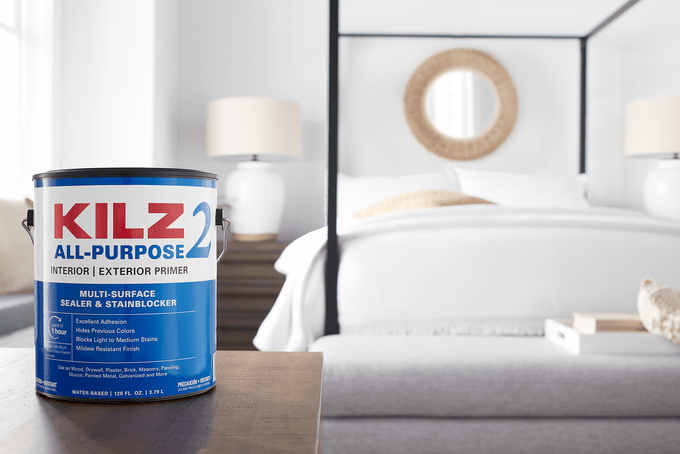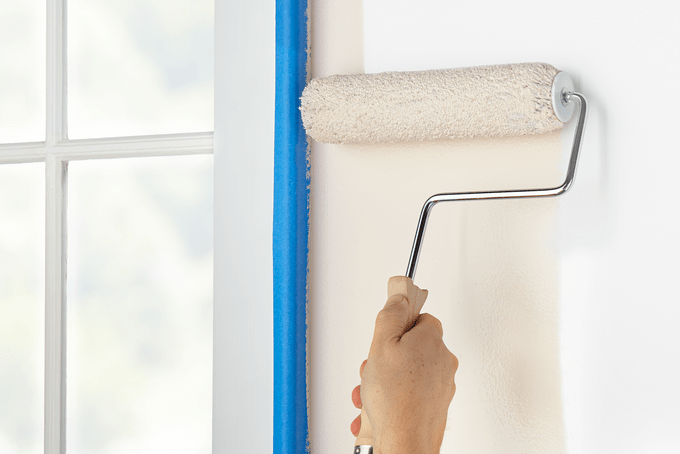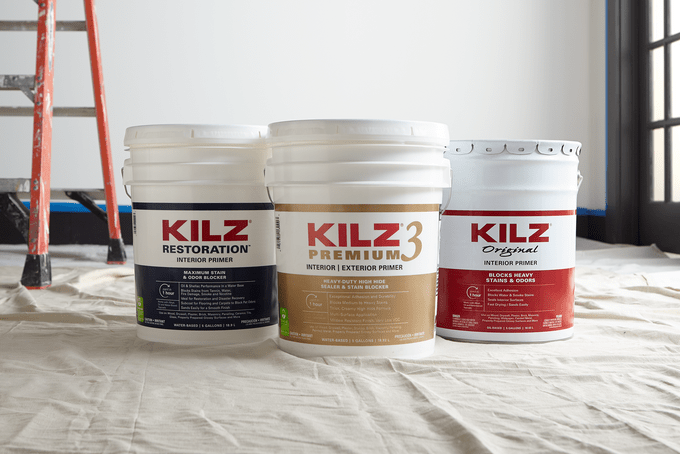Unfortunately, not all primers are in the same league. While it may be tempting to cut corners, a superior primer like KILZ® branded primer is key to a uniform, professional-looking paint job. After all, it lays the foundation for what’s to come and has everything to do with the end result.
Choosing the right primer for the job
When choosing a primer, one size fits all does not apply. It’s important to consider the condition of the surface you’re going to paint. Be sure to identify any issues that could prevent proper adhesion or compromise the quality of the color and finish. Then, choose a primer that properly addresses them.
A multi-surface interior/exterior primer—like the water-based KILZ 2® ALL PURPOSE or KILZ 3® PREMIUM primer has low odor and low VOC and is just the ticket to properly prepare typical surfaces for painting for most common situations. An oil-based primer such as KILZ® ORIGINAL interior primer is a great choice for blocking more severe stains and sealing odors and goes on well on wood and coated metal surfaces.

Encounter even more serious issues? You may need a primer that’s specially engineered to solve them.
Specialty primers tackle an array of situations. That includes preventing mold and mildew before painting. Consider KILZ® MOLD & MILDEW interior and exterior primer. Need a transparent finish for same color recoats? That’s where KILZ KLEAR® interior and exterior primer comes in. KILZ KLEAR® is also ideal for handling powdery chalky surfaces, concrete, cement and unpainted plaster with its alkali-resistance allowing application on masonry surfaces with pH up to 12.5. Need a primer for tough-to-adhere surfaces such as Kynar®, PVC, vinyl, Formica®, glass, tile, glazed brick, chalky paints, glossy finishes, fiberglass or metal? KILZ ADHESION® interior and exterior primer is a painter’s best friend. And if you’re experiencing more severe, restoration-type stains such as heavy water stains, tannin, smoke or fire damage stains? That’s where a primer like KILZ RESTORATION® interior primer comes into play. It’s also great for blocking and sealing odors like pet odors, nicotine, food and musty odors.
Be sure to check out the primer selector tool at www.kilz.com for added insight. To ensure you don’t overestimate, or underestimate, how much primer you need, there’s also KILZ Coverage Calculator, a handy tool that helps determine how much paint you need to start—and finish—a project.
What sets KILZ primers apart
There are times when you need to seal porous surfaces before painting to achieve a uniform finish; want to use fewer coats of paint; or must block water, tannin or smoke stains from bleeding through to your topcoat. Fortunately, you can count on adhesion-promoting KILZ® primers. KILZ® has a line-up of multi-purpose water-based and oil-based primers that is ideal for most priming needs.
KILZ® 1 STANDARD interior primer is designed specifically for multiple types of interior surfaces including drywall, wood, brick and masonry. KILZ 2® ALL-PURPOSE interior and exterior primer is made for interior and exterior surfaces that require high-hiding, stain-blocking and strong adhesion performance coupled with mildew resistance. For heavier-duty jobs, KILZ 3® PREMIUM interior and exterior primer offers a thicker, whiter-color primer that has excellent adhesion and more powerful stain blocking performance.
As for KILZ® branded specialty primers, they help you achieve optimal results in specific—sometimes challenging—situations. That’s true whether it’s a mold-prone area; or a tricky hard-to-stick surface that demands the performance of a high-adhesion bonding primer; or a primer that is alkali-resistant and can be applied to hot concrete or masonry surfaces.
Provided the surface is properly prepared and the primer is correctly applied, KILZ® primers will most always extend the performance and life of your paint job by laying a smooth, even base beneath your topcoat. Basically, it acts as the “glue” that makes the paint stick strongly and evenly, for most circumstances.

Here’s some more good news: KILZ’s water-based primers are considered “low odor.” While its oil-based primers inherently have a much stronger odor, KILZ® ORIGINAL LOW-ODOR primer has less odor than typical oil-based primers, thanks to its fast, odor-dissipating technology.
Tips for when you’re on the job
Whatever the situation, failing to clean the surface prior to applying primer may compromise its adhesion. That could lead to peeling and blistering. And while it may be tempting to hurry things along, don’t rush it—dry times shown on a can of primer are the minimum that’s recommended. A full cure takes longer—typically 12-24 hours.
It’s important to note that priming outside is just as, if not more, important than priming inside. Exterior surfaces typically are exposed to the elements, making them subject to expansion (from heat) and contraction (from cold). This and the exposure to wind, rain, snow, dust, dirt, pollution and UV rays may cause paint to fail due to lacking adhesion. Using an exterior primer first on a properly prepared surface can make a big difference in ensuring the paint lasts rather than cracking, peeling or blistering after a short period of time.

As a pro, you know the important tips to get the best results.
- Ensure the surface is clean and free of dust, dirt and debris
- Do not over-apply the primer to the surface
- Primer doesn’t have to look as finished as the topcoat (this can be a continuation of the previous bullet)
- Give extra focus to problem areas, whether it’s uneven, porous spots; scuffs, blemishes or stains; bright colors; or glossy, slick surfaces. Spot prime or apply an extra coat to such problem areas.
- Lightly sand the surface before applying primer to glossy surfaces
While today’s advanced chemistry allows compatibility between oil-based and water-based primers and topcoats, it is still best to keep things matched-up—“oil-based over oil-based” and “water-based over water-based.”
The bottom line? Primer matters. So does using a premium primer like KILZ® branded primer.